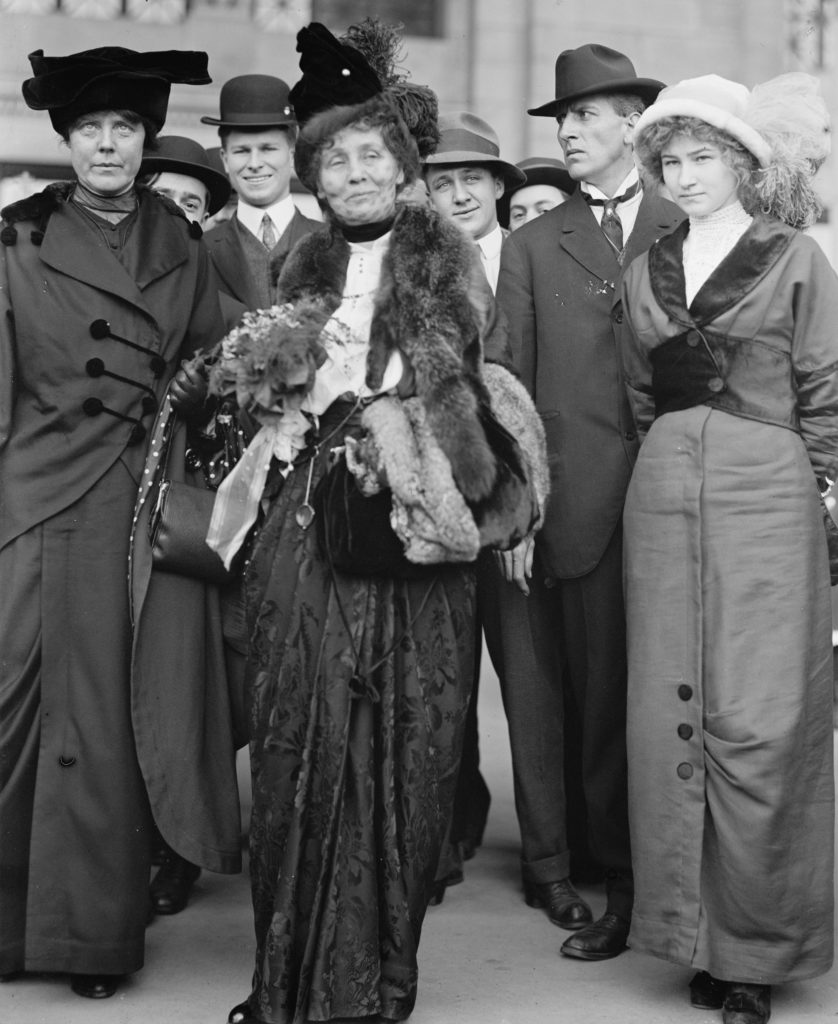By Walter Woodward
(c) Connecticut Explored Inc. Summer 2020
Subscribe/Buy the Issue!
When Emmeline Pankhurst arrived in Hartford in late November 1913, she was one of the most famous—and infamous—women in the world. As founder in 1903 of England’s Woman’s Social and Political Union (WSPU), an openly militant suffrage organization, Pankhurst was a flashpoint figure in British women’s struggle for the vote. The charismatic Pankhurst had organized the WSPU like a military unit, with strict discipline and a top-down command structure, as the New York journal Current Opinion noted in its January 1913 issue. Hotheads were weeded out and new recruits tested before entering the front lines of the suffrage battle. Led by Pankhurst, the WSPU’s suffragist confrontations had been characterized by slowly but steadily escalating violence since the organization’s founding.
By 1913 Pankhurst had come to believe full-scale violence and suffragist martyrdom were necessary. After the WSPU called on “every single woman in the ranks of the Woman’s Movement to come out and fight,” Current Opinion reported, “feminist Bedlam” ensued. Pankhurst’s “suffragettes” (a pejorative term the WSPU had embraced) poured acid in mailboxes, bombed the country homes of leading political figures, and provoked riots in London, Glasgow, and Wales. Pankhurst was arrested in January 1913 and sentenced in April to three years in prison, The Hartford Courant reported on April 4.
Suffragettes, however, had learned the public relations power of the hunger strike. By refusing to eat, imprisoned suffragists confronted authorities with the publicly intolerable options of letting women starve and die or painfully force-feeding them. British officials had reluctantly adopted a “cat and mouse” policy, letting hunger strikers starve until it affected their health, then releasing them to face re-imprisonment as soon as their health improved. Pankhurst, an experienced hunger striker, gained early release in this way from prison, when, gaunt and frail, she appeared at a London rally of the WSPU and challenged the government to “Give me freedom or kill me,” as The Courant reported on July 15.
A few months later, with the WSPU in desperate need of funds, Pankhurst came to America on a speaking tour, The Courant reported on October 26. While cities such as Pittsburgh rejected Pankhurst’s appearance because of her endorsement of violence, Hartford suffragists welcomed her with open arms. A large crowd greeted her arriving train, and after a reception at Theodate Pope’s home in Farmington (now Hill-Stead Museum), Pankhurst returned to Hartford. There, on November 13, 1913, after being introduced by suffrage leader Katherine Houghton Hepburn at Parsons Theatre, she delivered what The Guardian newspaper has called one of the 20th century’s great speeches. With powerful eloquence, Pankhurst described the long struggle of women to attain suffrage in England, drawing frequent parallels to the American Revolution. In a line reminiscent of American patriot Patrick Henry, Pankhurst explained the logic behind the suffragists’ hunger strikes: “We will put the enemy in the position where they will have to choose between giving us freedom or giving us death.”
Though reporters for The Courant played down the impact of the “notorious militant’s” “Freedom or Death” speech, the actual response to her oration shows otherwise. Attendees, both male and female, donated generously to her cause, and Pankhurst left Hartford the next morning having raised $1,400 (more than $35,000 today). Two days later, she sailed for England, where she was immediately re-imprisoned by authorities.
Read Emmeline Pankhurst’s Hartford speech, November 13, 1913, at awpc.cattcenter.iastate.edu/2017/03/09/freedom-or-death-part-1-nov-13-1913/.

